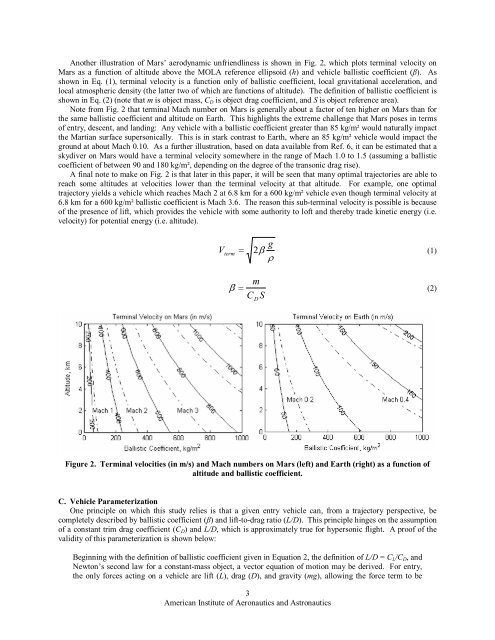Mars Entry Bank Profile Design for Terminal State Optimization
Mars Entry Bank Profile Design for Terminal State Optimization
Mars Entry Bank Profile Design for Terminal State Optimization
Create successful ePaper yourself
Turn your PDF publications into a flip-book with our unique Google optimized e-Paper software.
Another illustration of <strong>Mars</strong>’ aerodynamic unfriendliness is shown in Fig. 2, which plots terminal velocity on<br />
<strong>Mars</strong> as a function of altitude above the MOLA reference ellipsoid (h) and vehicle ballistic coefficient (β). As<br />
shown in Eq. (1), terminal velocity is a function only of ballistic coefficient, local gravitational acceleration, and<br />
local atmospheric density (the latter two of which are functions of altitude). The definition of ballistic coefficient is<br />
shown in Eq. (2) (note that m is object mass, C D is object drag coefficient, and S is object reference area).<br />
Note from Fig. 2 that terminal Mach number on <strong>Mars</strong> is generally about a factor of ten higher on <strong>Mars</strong> than <strong>for</strong><br />
the same ballistic coefficient and altitude on Earth. This highlights the extreme challenge that <strong>Mars</strong> poses in terms<br />
of entry, descent, and landing: Any vehicle with a ballistic coefficient greater than 85 kg/m² would naturally impact<br />
the Martian surface supersonically. This is in stark contrast to Earth, where an 85 kg/m² vehicle would impact the<br />
ground at about Mach 0.10. As a further illustration, based on data available from Ref. 6, it can be estimated that a<br />
skydiver on <strong>Mars</strong> would have a terminal velocity somewhere in the range of Mach 1.0 to 1.5 (assuming a ballistic<br />
coefficient of between 90 and 180 kg/m², depending on the degree of the transonic drag rise).<br />
A final note to make on Fig. 2 is that later in this paper, it will be seen that many optimal trajectories are able to<br />
reach some altitudes at velocities lower than the terminal velocity at that altitude. For example, one optimal<br />
trajectory yields a vehicle which reaches Mach 2 at 6.8 km <strong>for</strong> a 600 kg/m² vehicle even though terminal velocity at<br />
6.8 km <strong>for</strong> a 600 kg/m² ballistic coefficient is Mach 3.6. The reason this sub-terminal velocity is possible is because<br />
of the presence of lift, which provides the vehicle with some authority to loft and thereby trade kinetic energy (i.e.<br />
velocity) <strong>for</strong> potential energy (i.e. altitude).<br />
V term<br />
= 2β g<br />
(1)<br />
ρ<br />
m<br />
=<br />
C S<br />
β (2)<br />
D<br />
Figure 2. <strong>Terminal</strong> velocities (in m/s) and Mach numbers on <strong>Mars</strong> (left) and Earth (right) as a function of<br />
altitude and ballistic coefficient.<br />
C. Vehicle Parameterization<br />
One principle on which this study relies is that a given entry vehicle can, from a trajectory perspective, be<br />
completely described by ballistic coefficient (β) and lift-to-drag ratio (L/D). This principle hinges on the assumption<br />
of a constant trim drag coefficient (C D ) and L/D, which is approximately true <strong>for</strong> hypersonic flight. A proof of the<br />
validity of this parameterization is shown below:<br />
Beginning with the definition of ballistic coefficient given in Equation 2, the definition of L/D = C L /C D , and<br />
Newton’s second law <strong>for</strong> a constant-mass object, a vector equation of motion may be derived. For entry,<br />
the only <strong>for</strong>ces acting on a vehicle are lift (L), drag (D), and gravity (mg), allowing the <strong>for</strong>ce term to be<br />
3<br />
American Institute of Aeronautics and Astronautics
















